from
http://redirect.viglink.com?u=http%3A%2F%2Fluxurylivingtips.com%2Fmore-than-half-of-u-s-employees-are-wasting-their-vacation-days%2F&key=ddaed8f51db7bb1330a6f6de768a69b8
Car rental company Europcar made adults feel like kids again with help from Mercedes-Benz.
To launch its new advertising campaign, centered on the customizable features of its rentals and its selection of luxury and fun cars, Europcar worked with Mercedes to construct a working carousel in London where adults could hop in and coast in one of the automaker’s newest models. This unconventional out-of-home placement and corresponding social video will not only help draw attention to Europcar, but may help inspire Mercedes aspirations among viewers.
Revolving ride
Europcar’s ad campaign, developed by agency Rosapark, focuses on the service provider’s ability to deliver on an individual basis, whether through its to my door delivery service or its range of luxury and fun cars. Photography of drivers is paired with a tagline that includes their name, a take on its existing tagline, “Moving your way.”
Taking the campaign beyond the out of home placements in airports, on its vehicle exteriors and at its branches, Europcar decided to add an element of joy with an adult carousel.
Featuring five new Mercedes models, the carousel was constructed in the center of London, ensuring it would be seen by passersby.
On video, adults become children again, giddy with the magical ride that appeared before them.
Europcar and Mercedes-Benz – The Carousel of Dreams
“We are delighted to have the opportunity to present this new, ambitious advertising campaign, which reflects our core mission: to provide our customers with a unique mobility experience that meets their individual needs,” said Sheila Struyck, Europcar group marketing director.
“As the European leader, our objective is to differentiate ourselves by offering innovative, simple and customized solutions that make all the difference,” she said. “That’s the entire theme of this customer-centric campaign.”
Taking out-of-home placements beyond a flat billboard can help get consumers involved, engaged and inspired.
U.S. apparel and accessories brand Marc Jacobs expanded on current promotions for its latest fragrance Daisy Dream with a social time capsule initiative.
The consumer could “join the thousands of dreamers around the world” by creating a Marc Jacobs Daisy Dream Dream Capsule. Participants received their Dream Capsule back from Marc Jacobs in a year’s time (see story).
Extending the effort, Marc Jacobs set up a lounge in New York’s Madison Square Park. Here, with the help of on-site iPads, consumers had the opportunity to add their dreams to a capsule.
Italian fashion label Giorgio Armani and French automaker Bugatti are teaming up to dress the man who seeks luxury in all areas of his life.
The first collaboration between the two brands features small leather goods and apparel in colorways and designs that reflect the automaker’s aesthetic. Launching for fall/winter 2016, this collection enables both partners to draw on their shared passion for quality and craftsmanship.
Like-minded
Complimenting the capsule collection’s color palette of army green and cognac, Bugatti’s signature blue makes an appearance in the lining of bags, the inside of pockets and in the insoles of footwear. The brand’s horseshoe emblem, seen on the front of its vehicles, has been fashioned into pendants for bags.
Within the leather goods assortment, crafted out of calfskin or crocodile, are a briefcase, a larger weekender, belts, wallets, iPad covers and beauty cases. Clothing includes a cashmere coat, blouson jacket and sweaters, a leather jacket and denim jeans.
“It was very natural to come together with Bugatti,” said designer Giorgio Armani in a brand statement. “We both worship things that are made well, made to last, created out of the best materials.
“The capsule condenses this encounter in a series of clothes and accessories designed to be worn by men who only look for the best and who live an active and dynamic lifestyle,” he said.
These pieces, made in numbered limited edition, each bear a Giorgio Armani for Bugatti label. The collection will be available beginning in August at Armani and Ettore Bugatti lifestyle boutiques.
“Cooperation with Giorgio Armani is a great honor for us,” said Wolfgang Dürheimer, president of Bugatti Automobiles.
“When one of the most influential and highly recognized fashion and lifestyle brands and the most exclusive super sports car brand in the world, which has its roots in art and design, join forces, this is an unusual, exciting and inspiring project,” he said. “The result is an extremely well-made combination of the style and perfection of Giorgio Armani and the Bugatti brand DNA.”
Looking to expand their offerings beyond cars, automakers have launched strategic partnerships.
British automaker Bentley is heading to the green with a new collection of bespoke golf equipment.
Bentley Golf, produced in collaboration with Professional Golf Europe, includes clubs, bags, luggage and accessories featuring details that mirror the look of Bentley vehicles. This collection brings the Bentley lifestyle to a new area of consumers’ lives, allowing loyalists to have more interaction with the brand on a day-to-day basis (see story).
French department store chain Galeries Lafayette is strengthening its ecommerce business with the purchase of InstantLuxe.com
Established by Yann Le Folc’h in 2009, InstantLuxe.com is an ecommerce site based in France specializing in the trading of pre-owned luxury goods. Galeries Lafayette purchased InstantLuxe.com outright for an undisclosed sum on June 29 but will keep Mr. Le Folc’h as the company’s head.
Secondhand news
Along with the purchase of resale site InstantLuxe.com comes its community of 700,000 members. Through the acquisition, it is likely that Galeries Lafayette will take advantage of these discerning consumers, many of whom may be untapped by the French department store.
InstantLuxe.com’s marketplace is used for the secondhand sale of certified luxury goods such as leather goods, jewelry, watches and accessories.
All products vetted by InstantLuxe.com undergo authentication processes by experts before being shared on its Web site.
Moving from online to in person, InstantLuxe.com staged its first physical point of sale last winter at the Bazar de l’Hôtel de Ville Marais flagship, a department store within the Galeries Lafayette stable.
The acquisition of InstantLuxe.com will accelerate Galeries Lafayette’s omnichannel strategy by offering its consumers a new shopping experience. Additionally, there has been a rising interest in luxury consignment among affluent consumers, the purchase of InstantLuxe.com gives Galeries Lafayette an in with this secondhand retail sector.
Bricks-and-mortar retailers have turned to online sellers to strengthen what they are offering online.
For instance, Saks Fifth Avenue owner Hudson’s Bay Company grew its off-price business with the addition of Gilt to its stable of banners.
With this acquisition, the retail group is planning to integrate Gilt within Saks Off 5th locations, giving the flash seller a bricks-and-mortar presence. As an innovative retailer with strong capabilities in mobile and personalization technology, Gilt may help HBC further the digital efforts of its more traditional stores.
HBC purchased Gilt for $250 million (see story).
Automotive group Volkswagen has reached a $10 billion class action settlement after the brand falsified emissions data on nearly half a million diesel models sold in the United States.
The Gregg Klein v. Volkswagen Group of America, Inc. case was filed in federal court in September 2015, days after the automaker copped to deceiving U.S. regulators and consumers. The emissions scandal impacted not only Volkswagen branded diesel vehicles, but also its high-end offerings such as Porsche and Audi, which are owned by the group (see story).
Paying up
The case against Volkswagen was filed by MLG Automotive Law and includes a number of “tag-along cases” that were consolidated into one class action suit. The case was overseen by the Honorable Charles Breyer of the U.S. District Court, Northern District of California.
On June 28, MLG and Volkswagen reached a historic settlement of $10 billion. The settlement is the largest automotive class action settlement in U.S. history.
Per the settlement agreement, Volkswagen will buyback or modify approximately 500,000 affected vehicles. The auto group will also have to pay consumers a civil penalty of at least $5,100 for each car purchased and $1,529 for vehicles that were leased.
Valued at more than $15 billion, the settlement only resolves class action claims for consumers who drove 2.0-liter diesel engines in the U.S. market. The case does not resolve the claims brought by owners of 3.0-liter engines. A U.S. dealership class action suit is also not resolved by this settlement.
Volkswagen vehicles sold outside the U.S. are not part of the class action settlement either.
“[The class action settlement] marks a historic day in our nation’s jurisprudence,” said Jonathan Michaels, founding member of MLG Automotive Law, in a statement.
“Not only is this the largest settlement of its kind in U.S. history, but manufacturers are finally being told that there are severe consequences for deceiving the public,” he said. “We look forward to continuing to support the claims of the dealers and the 3.0-liter owners, both of whom were not involved in [the June 28] settlement.”
Additional details of the court settlement can be read here. Volkswagen has shared the link across its social media accounts to keep its consumers updated.
In recent weeks, the auto industry has seen a number of lawsuits filed.
For example, U.S. electric automaker Tesla Motors is under fire for a term in a goodwill agreement related to a potentially faulty suspension.
Consumer-rights law firm Hagens Berman is investigating the agreement, which allegedly restricts the rights of owners in the event of defects or other wrongdoings on the part of Tesla. Mandatory silences are becoming a more common tactic among businesses and have a history in the automotive sector, but the allegations contradict Tesla’s transparent and responsible image (see story).
British department store chain Selfridges is embracing literal retail theater with a celebration of the work of renowned playwright William Shakespeare.
In honor of the 400th anniversary of the Bard’s death, the retailer is launching a multichannel campaign, “Shakespeare Refashioned,” updating some of his most popular plays through a fashion-forward filter. Through this celebration, beginning July 4, Selfridges is able to showcase its affection for the arts while highlighting its British heritage.
“We always strive to surprise, amaze, and amuse our customers so the opportunity to stage an homage to Shakespeare, arguably the world’s most famous theatre author, was too good to miss,” said Linda Hewson, creative director at Selfridges, London.
“Our brand’s DNA is steeped in retail theatre,” she said. “We were the first retailer to introduce this concept in Europe when we opened in 1909, so the correlation between this campaign and what we do every day fits perfectly.”
Lifting the curtain
For this campaign, Selfridges is opening a 100-seat theater on its lower ground floor, a first for a department store. Being built in partnership with LG, the theater will house theater company The Faction’s production of “Much Ado About Nothing.”
The Faction is staging a modern interpretation of the play, placing it in today’s society, complete with 24-hour tabloid coverage.
Selfridges Presents: Shakespeare Refashioned
While the theater and play will not officially open to the public until previews begin on Aug. 23, Selfridges is giving consumers a backstage pass to the process of staging a production. In the empty space, they can watch rehearsals unfold or get a look at the creation of character through makeup with help from partner MAC cosmetics.
For two weeks, this theatrical blank canvas will also be home to hands-on workshops and masterclasses from the Royal Academy of Dramatic Art (RADA), through which consumers can seek their expertise in acting, auditioning, stage combat and Shakespeare-era dancing.
RADA is also bringing some of Shakespeare’s work to life through an audio series. Accessible from Selfridges’ Web site, the first recitation is by Sir Kenneth Branagh.
Cult streetwear brands including Caitlin Price, Astrid Andersen and Life’s A Beach are co-hosting a series of spoken word, music and art performances running from July to September. Opening up the experience to more than those gathered in the Refashioned Theater, these events will be simulcast on Periscope and Snapchat.
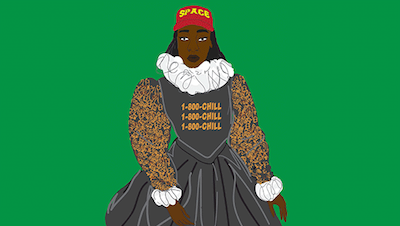
Shakespeare Recited promotional image
For the first performance of Shakespeare Recited, spoken word artist James Massiah will read a trio of poems inspired by Shakespeare, underscored with beats by DJ Maximum and Preditah. Novelist will make a comparison between Shakespeare’s exploration of modern life and the topical nature of MCs and rappers’ work today.
Also exploring Shakespeare’s place in history and today, 5×15 is hosting a series of three talks about the Bard, in which speakers will discuss everything from their personal relationship to his plays to using Shakespearean literature as an advice columnist for modern day problems.
Tying the campaign to modern fashion, Selfridges has asked 20 high fashion labels to create one-of-a-kind designs that reference some of the most iconic Shakespeare plays. The results will be displayed in theatrical window scenes at the retailer’s Oxford Street flagship in London.
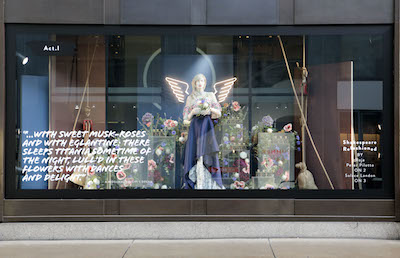
Window display depicting A Midsummer Night’s Dream; photo by Matt Writtle
Act I, which premiered June 27 and will run through Aug. 28, concentrates on light themes. Alexander McQueen’s floral designs are fit for fairies in a wooded scene recalling “A Midsummer Night’s Dream,” while Christopher Kane’s Juliet is positioned in a modern metal balcony.
A second act surrounding the dark will debut Sept. 5 and run until mid-October.
![Selfridges launches Shakespeare reFASHIONed_Coriolanus window_3[7]](https://www.luxurydaily.com/wp-content/uploads/2016/06/Selfridges-launches-Shakespeare-reFASHIONed_Coriolanus-window_37.jpg)
Selfridges window display paying homage to Coriolanus; photo by Matt Writtle
Consumers can shop an edit of Shakespeare-ready apparel and accessories from Balmain, Smythson and Edie Parker, including 120 exclusives from 50 different labels.
Further exploring the theme, photographer Mary McCartney will be shooting the latest fashions for a still image and a film. Her video, along with footage of interviews, performances and other special content, will run on Selfridges’ content channel Hot Air.
On Selfridges’ social media accounts, the store is driving a social conversation and foot traffic with the hashtag #GetTheeToASelfridges, a play on a line Hamlet delivers to Ophelia.
Topical retail
Selfridges frequently brings together experts and creatives for campaigns that inspire consumers to not only shop but contemplate a particular topic.
Last year the retailer investigated the changing face of employment, from shifting work-life balance to innovations in enterprise, with a multichannel campaign.
“Work It!” included in-store workshops, displays and online content which feature forward thinkers on the subject and products to help consumers regain some “me-time” in today’s world. This campaign speaks to pandemic issues, allowing Selfridges to connect with its consumers and create a conversation (see story).
A luxury brand’s retail environment should be carefully orchestrated to make consumers want to participate in the store experience, according to panelists speaking at the French American Chamber of Commerce’s “The Luxury Retail Store: Real Estate, Design and Customer Experience Trends” event.
During the presentation Nov. 12, one resounding theme was that the increase in luxury’s presence online has removed the necessity of interacting with a bricks-and-mortar location, creating a need for a sense of theater and engagement to draw consumers away from other possible activities to shop. By going above the traditional store design, bricks-and-mortar retail can better compete with online channels for revenue (see story).
“With Shakespeare Refashioned, we have the opportunity, especially by opening a live, fully-functioning theatre within our London store, to magnify and elevate the retail theatre experience we provide our customers like never before,” Ms. Hewson said. “We’re very excited to see how our customers will respond to this engaging new initiative.”
British department store Harrods is proving itself as a leading horological destination with a storewide fine-watch takeover that touts its dedication to the category.
Harrods’ “Made with Love and Precision” in-store campaign begins on July 1 and will extend into the first two weeks of August. The campaign, marked by displays and in-store exclusives, is Harrods’ way of paying tribute to the high-end timepiece portfolio available in its Fine Watch Room.
“With the right retailer and the right promotional campaign, the high-end watch industry, which is really the jewelry industry, as it’s more than a watch, should benefit from this program,” said Eric Tunis, partner at Friedman LLP.
“To have Harrods deliver the message is great for the industry,” he said.
Mr. Tunis is not affiliated with Harrods, but agreed to comment as an industry expert.
Harrods was unable to comment by press deadline.
Wonders of the Fine Watch Room
To create Made with Love and Precision, Harrods worked closely with the watchmakers it carries within its Fine Watch Room.
Made with Love and Precision will include an in-store exhibition within the department’s exhibit space and Harrods’ first-ever Brompton Road window displays dedicated to horology.
Working with watchmakers also allowed Harrods to time a number of new timepiece launches with the start of Made with Love and Precision. With many of these watches exclusive to the London retailer, Harrods is likely to see an increase in horologists vying to see the latest timepieces designed by industry leaders.
For the window displays facing Brompton Road, Harrods will focus on craftsmanship and rare materials. To showcase these points, the windows will feature an oversized version of each timepiece fitted with a particular type of material in a dedicated window pane.
Swiss watchmaker Roger Dubuis was selected for the windows and will celebrate the retail launch of its Black Velvet Trilogy and Excalibur 45 Skeleton Double Flying Tourbillon with black spinels alongside Harrods. Both watches retail for £26,000, or $34,646 at current exchange rates.
Similarly, a number of watch brands have designed bespoke men’s and women’s timepieces to be launched exclusively during Made with Love and Precision.
Highlights include Panerai’s limited-edition PAM00693 Luminor Marina 1950 3 Days Automatic Titanio. The watch features a green dial and the Harrods logo engraved on its caseback.
Harrods will also be the setting for notable launches include Bremont’s nearly $90,000 B2 Marine Chronometer, the exhibition’s sole clock, designed to celebrate the watchmaker’s partnership with America’s Cup.
Others include the $39,000 Breguet’s Classique Special edition 7337, the first edition of this model to feature a blue dial, and Omega’s Speedmaster Grey Side of the Moon “Meteorite” watch with meteorite dial, which made its debut at Baselworld 2016.
Limited-edition pieces featured in Made with Love and Precision include Cartier’s Rotonde de Cartier Mysterieuse Double Tourbillon, making its global debut at Harrods. The limited-edition timepiece was created in a 100-piece series.
Upping the exclusivity is Harry Winston, which will display its Premier Moonphase 36mm timepiece at Harrods. The Premier Moonphase, which debuted at Baselworld 2016 and is limited to only five pieces globally, retails for $34,263.
Harrods is also vetting consumer experience within its Fine Watch Room and around the store. Sales associates will be on-hand to assist in showing consumers exclusive product offerings and bespoke services.
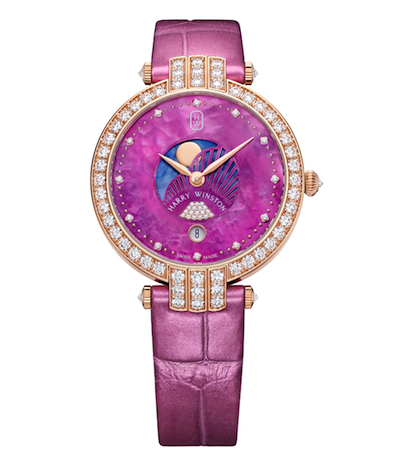
Harry Winston’s Premier Moonphase 36mm
“We are delighted to celebrate our exceptional watch offering with the launch of Made with Love and Precision,” said Jason Broderick, fashion director of menswear, sports and fine watches at Harrods, in a statement.
“The six-week-long takeover will feature special-edition timepieces created exclusively for Harrods, innovative retail theatre and 23 extraordinary timepieces launching exclusively in-store,” he said.
“This exciting campaign — the first of its kind for Fine Watches at Harrods — will further establish us as the ultimate fine-watch destination.”
Watches in focus
In the past, Harrods has orchestrated smaller scale efforts with watchmakers carried in the Fine Watch Room.
For example, Swiss watchmaker Richard Mille hosted a pop-up exhibition at Harrods to immerse consumers in its artisan production.
The brand set up shop in the retailer’s windows, enabling consumers to enjoy the installation from afar on the street or interact with the display by entering the store. Placing such an exhibit inside a department store, especially one that receives heavy tourist foot traffic, enables a brand to share its story with a wide audience (see story).
Likewise, watchmakers have turned to Harrods to showcase expertise and standing by creating bespoke pieces exclusive to the London department store.
For instance, British jeweler and diamond company Backes & Strauss honored the prestige of London-based retailer Harrods through the creation of a “pièce unique” women’s watch.
Together with responsibly-sourced precious stone supplier Gemfields, Backes & Strauss’ created the “Harrods Princess” to celebrate the retailer’s La Biennale des Antiquaires 2014 in London. Given that Backes & Strauss only recently entered the timepiece market in 2006, the brand likely benefited from having a one-off timepiece present during Harrods’ event (see story).
As shopping habits evolve to be increasingly experiential, in-store programming may work to capture the attention of affluent consumers, especially those in the millennial age bracket.
“High-net-worth consumers may have changed their buying habits post-Lehman Brothers bankruptcy at the end of 2008,” Mr. Tunis said.
“Some of our clients that sell diamond jewelry to the high-net-worth consumer are marketing differently, and are marketing to them globally,” he said. “A consumer might have stopped in at a client’s store in one part of the world, and our client later reached out to their client in another city where they know they live or shop.
“One question everyone is asking is, ‘What will the next generation of consumers want, what do they want in jewelry and how can we deliver a message to them?'”
Automotive shoppers begin research interested in brand reputations, but make purchase decisions on more practical matters, according to a report from Jumpstart Automotive Group and Ipsos Connect.
Good value, a reputation for being strong and reliable and a reputation for excellent quality are the top three concerns initially, but quality/reliability, mileage and pricing are ultimately the biggest influencers. However, these numbers differ noticeably among different demographics, and brands need to vary their value proposition according to target market.
“Shoppers are very price and value conscious, and both play an integral role in the decision-making process,” said Libby-Murad Patel, vice president of strategic insights and analytics for Jumpstart Automotive Group. “In our research, we found that ‘good value for the money’ is a top must-have and is the primary trust-related concern consumers have with dealerships.”
For “Today’s Auto Shoppers: How They Research and Why Trust is So Essential in Winning Them Over,” 1,014 United States adults who have purchased a vehicle in the past year were surveyed to discern trends in automotive purchasing and differences among key demographics.
Demographic differences
According to Navigant’s research, a majority of shoppers –including luxury shoppers – have a general idea of what they want when they begin the purchase journey, generally having three brands, two body styles and three models in mind.
These initial contenders are based largely on what “catches their eye” on the road or on TV commercials and via word of mouth. When they begin researching, however, the Internet dominates.

Still from Lexus’ “Beautiful Contrast”
Consumers rely in roughly equal portions on dealer sites, Google searches and auto research sites, with “Consumer Reports” and OEM sites following.
Despite their usage rates, many consumers expressed skepticism of the information on a manufacturer’s site, claiming that they need third party sites to get a realistic idea of issues associated with a particular model. Dealer, brand and OEM sites are primarily used to find deals and pricing information.
Among all demographics and income levels, BMW, Mercedes-Benz and Porsche are considered the top luxury brands, with Audi, Lexus and Cadillac also showing well. Interestingly, affluent consumers are significantly more likely to consider Audi and Tesla as luxury brands than non-affluents, likely a testament to an exactingly segmented marketing mix.
As the research shows, different demographics have different concerns and thus respond discretely to advertising.
Women now influence 80 percent of vehicle purchases. On the whole they are more concerned with price than men are, meaning that competitively priced vehicles could gain an edge by marketing more directly to women.
Women are also high-information voters and more likely to consult “Consumer Reports,” and focus on practical elements such as warranty and mileage. While TV commercials often focus on creating desire, brands should target women with transparent, high-information ads.
“We heard a number of women in our focus groups say that they have worked hard, raised their children, held a career and now they’re at the point that they feel like they deserve something more luxurious,” Ms. Patel said. “Similarly, we heard parents in general talk about waiting to buy a luxury vehicle until their kids were a little bit older so that they could maintain it and enjoy it more.”
Asian-American and Hispanic consumers, meanwhile, are more interested in electric- and hybrid-vehicles than other demographics. Both demographics, but especially Asian-Americans, put more stake in brand reputation.
Asian-American consumers are also least trusting of dealerships they purchase from and least likely to use magazines and newspapers.
Consumer retention
Although online media is the most frequently used platform for research, automakers should think twice before stopping the literal presses.
Even as digital mounts a speedy takeover of the marketplace at various points of the purchase journey, brochures still have a place in the automotive world, according to a Foresight Research study.
A brochure influenced the same proportion of buyers in 2015 as in 2008, and the same percentage preferred to pick one up in person as opposed to finding it online. Understanding the significance of what may seem to be an outdated marketing tool can help brands reach consumers (see story).
Luxury automakers also need to improve their vehicle initial quality, otherwise they risk losing today’s customers to competitors in the future.
Non-premium brand automobiles have higher-quality new vehicles than their premium counterparts.
While premium brands averaged 108 problems per 100 vehicles within the first three months of ownership, non-premium brands averaged 104. Initial quality is correlated with repeat business, suggesting that luxury brands should get back to basics and improve quality control before proceeding to make sales (see story).
“Throughout the study, we found that demographics have different priorities, styles of researching and expectations,” Ms. Patel said. “What this means for dealers is that customization of deals, and the way in which the customer relationship is cultivated, must be unique for each demographic, as much as possible.
“It’s no longer enough to treat demographics uniquely once they’re in the showroom, but by understanding the priorities and factors that influence these shoppers before they even get to the dealership,” she said.
“Dealers must approach each demographic uniquely during the research and shopping phase, as well. This can greatly impact your digital marketing strategies in both media and messaging.”
British automaker Bentley is heading to the green with a new collection of bespoke golf equipment.
Bentley Golf, produced in collaboration with Professional Golf Europe, includes clubs, bags, luggage and accessories featuring details that mirror the look of Bentley vehicles. This collection brings the Bentley lifestyle to a new area of consumers’ lives, allowing loyalists to have more interaction with the brand on a day-to-day basis.
Driving range
Bentley Golf’s clubs are hand forged in Ichikawa, Japan, a town whose forging heritage dates back to samurai sword-making. The clubs’ shafts are made of steel or graphite with custom leathers for the grip.
To house the clubs, Bentley has created bags made of waterproof materials, including leather.
Accessories include golf balls, a ball marker made of sterling silver, a leather glove, bag towel, umbrella, a cap and golf tees.
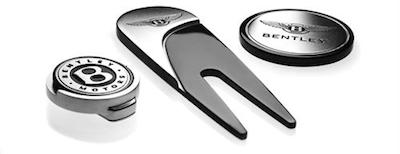
Accessories from Bentley Golf collection
Design details reflect the lines of the Continental or Mulsanne, and luggage and clubs feature signature looks such as quilting and knurling.
Bentley has been extending its brand further into lifestyle products.
In 2014, Bentley Motors embarked on a five-year partnership with high-end smartphone manufacturer Vertu to further round out its lifestyle options.
Both brands build their products in Britain, so the amplified heritage will likely appeal to consumers looking for authenticity (see story). The pair recently released their third phone together (see story).
Bentley has continued to establish itself as a choice purveyor of more than just cars.
Last September, the company unveiled its new luxury collection at the Frankfurt International Automobile Exhibition. With seven lines of clothing, accessories and more, Bentley relies on its loyal consumers to diversify its brand and differentiate it from its automotive competitors (see story).
British department store chain Harvey Nichols’ comical look at shoplifting has earned the 2016 Film Grand Prix at the Cannes Lions International Festival of Creativity.
The retailer’s short video, created and entered by agency Adam & Eve/DDB, edits real security footage captured at Harvey Nichols’ stores, with the message that enrolling in its rewards program is a way to earn freebies legally. The whimsical film that caught judges’ attention has also been an awareness-building success for the store, with more than 500,000 views since it launched almost a year ago.
Stealing attention
Harvey Nichols’ ad, produced by Blink Productions, Cain & Abel and The Mill, superimposes cartoon faces onto shoplifters, to “protect the guilty.” The CCTV footage catches these nefarious shoppers in the act, as they look around and stuff merchandise in their bags or under their coats.
After watching them steal, the footage follows these criminals as they try to leave the store, when they are flagged down by security. The last shots show the shoplifters beside themselves, shaking their heads as they wait for the authorities.
Love freebies? Get them legally. Rewards by Harvey Nichols
The final message is the tagline, “Love freebies? Get them legally.” Harvey Nichols then provides links to its rewards app.
Also in the film category, BBDO Mexico took home Bronze Lion Campaign for its work with Mercedes-Benz on “Co-Worker and “Son’s Friend,” while Audi of America’s “Commander” Super Bowl spot by Venables Bell & Partners won a Bronze Lion.
Adam & Eve/DDB has previously worked with Harvey Nichols on a number of campaigns, helping the retailer communicate its playful attitude.
For instance, Harvey Nichols showed the impact its newly remodeled menswear shopping destination could have on iconic figures’ images.
The retailer’s campaign operates on the premise that “Great Men Deserve Great Style,” giving personalities as diverse as Charles Darwin and Barack Obama a sartorial update. This cheeky take on the power of fashion may help convince consumers that they too could work on their style (see story).
The difference between the most optimistic and most pessimistic scenarios for retail through 2030 is $5.5 trillion, according to A.T. Kearney.
Depending on the impact of the Trans-Pacific Partnership (TPP), China’s economic performance, growth in emerging markets and myriad geopolitical factors, revenue could reach $17.8 trillion. Many factors are out of brands’ control, meaning agility and foresight on geographic and political scales are the key attributes of the future.
“Emerging Market Retailing in 2030” summarizes patterns of growth in recent years and examines four separate scenarios for future growth spanning technological and geopolitical/economic factors.
“Emerging Markets have been the main engine of growth for luxury in the past decade especially China, Russia, Middle East and Brazil,” said Hana Ben-Shabat, partner in the retail practice of A.T. Kearney and co-author of this study.
“Going forward there will be growth coming from places like Indonesia, and India where the growth in high net worth individuals has been vibrant, along with the growth of the middle class,” she said. “Accessible luxury as a category is more applicable with the growing middle class.”
Four scenarios
The three forces that will exert the largest influence on the business world in 2030 are rising geopolitical instability, persistent economic uncertainty and accelerating technical adoption.
Today, these traits are already seen in Middle Eastern conflicts, Russia’s relations with the West, lifting of sanctions against Iran, tensions on the South China Sea, Brazil’s implosion, oil prices and its related impacts and the way ecommerce has enabled entry into emerging markets.
A.T. Kearney devised four disparate scenarios that could result from the interplay of these factors. In one, cross-border integration and the adoption of technology create a best-case scenario for retailers.
In this “Seamless Dreams” scenario, the TPP will be implemented in 2018 and see more nations join in 2023, while African infrastructure investments begin showing results in 2022.
However, the looming threat of recession and protectionism, along with insufficient development of technological infrastructure, could force international retailers to focus domestically once again in a “Back to the Past” scenario. If China’s slowdown and continues and India follows and NAFTA sees push back as well, FDI flows will decelerate and hinder technology.
In this model, however, swelling income inequality allows luxury brands to prosper by targeting the ultra wealthy even as “accessible luxury” becomes unaffordable to the middle class of emerging markets.

Chinese consumers at a Louis Vuitton boutique
In one model between the two extremes, China reforms its hukou, or housing system, and resumes fast growth, but cyber-attacks become common enough to stifle ecommerce growth. In this model governments embrace free trade but consumers remain skeptical, thereby limiting retail to competitive urban centers, resulting in a 3.9 percent CAGR compared to a 3.4 percent baseline.
Luxury will thrive in this model, as the relative revitalization of in-store plays to their strengths, and the historical concentration of wealth in urban areas means luxury is inoculated from a rural demise.
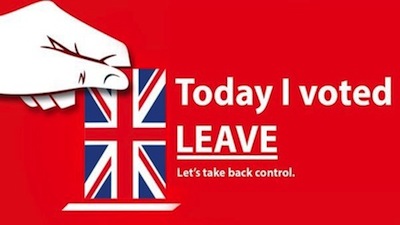
The UK’s withdrawal from the European Union signals the growth of protectionist sentiment
Lastly, a failure to embrace open trade might mean that only countries with pre-existing tech resources offer expansion opportunities. Continued instances of nationalist populism would eventually suffocate resource development in emerging markets, resulting in a growth rate only slightly higher than the worst-case scenario.
Long-term analysis
The growth regions are discrete across the four scenarios, meaning that brands will need to base their investments on complex market analyses and be ready to pivot quickly if necessary. As certainty of one model or another increases, brands need to be able to quickly adapt their strategies and beat competition to the largest growth segments, whether they are established or domestic markets.
Already, political events unthinkable mere months ago are carrying economic repercussions that brands will have to navigate.
Last week, the United Kingdom voted to leave the European Union, a decision that is already having an impact on the global markets.
A referendum held on June 23 passed with 52 percent of British voters choosing to leave the E.U., the news of which caused a $2 trillion hit to global stocks, the pound to fall 10 percent to the dollar and the euro to drop 3 percent. Britain’s secession from the political-economic union will be a two-year process, but the impact of this time of uncertainty has been immediate (see story).
When looking for emerging markets replete with growth potential, a previous A.T. Kearney report notes that alongside China and India, Malaysia, Kazakhstan and Indonesia are the most promising.
China and India are predictably the two most markets with the most potential, thanks in large part to their enormous populations, but the APAC region in general is full of promise. With retail sales in developing markets now constituting more than half of global revenue, brands must be precise in determining which developing markets offer the greatest opportunity (see story).
“[if income inequality continues to rise] it will [suffocate emerging markets], in which case the focus will be more on the top layer of the population in terms of wealth,” Ms. Ben-Shabat said. “But that alone will not be sufficient to replicate the historical double digit growth we have seen in places like China and Russia, before those two countries started to slow down.”
United Kingdom-based secured lender Borro is predicting hard luxury assets, including art and classic automobiles, to be tangible stores of wealth in the aftermath of the European Union referendum.
Last week on June 23, U.K. citizens voted to leave the EU as the referendum passed with 52 percent of voters choosing to exit, the news of which caused a $2 trillion hit to global stocks, the pound to fall 10 percent to the dollar and the euro to drop 3 percent. Britain’s secession from the political-economic union will be a two-year process, but the impact of this time of uncertainty has been immediate (see story).
Placing bets
As stocks and the pound dropped following the Brexit vote, the price of gold rose by 6 percent, and 20 percent if sterling fluctuations were taken into account. Per Borro, this serves as an indication that investors are seeking ways to protect themselves in an uncertain market.
“Economic uncertainty often leads to increased activity in different markets, including luxury assets,” said Samantha Lilley, director of Valuations at Borro, in a statement. “Buyers are looking for a tangible store of wealth to protect themselves against volatile financial markets.
“Additionally savvy collectors will be watching auctions, looking for opportunities to generate long term returns,” she said.
The first major auction held after the Brexit results saw the sale of a 1938 Jaguar Roadster. Auctioned by Bonham’s during the Goodwood Festival of Speed June 24, the Jaguar was expected to fetch between £180,000 – £260,000, or $237,489 to $343,111 at current exchange rates.
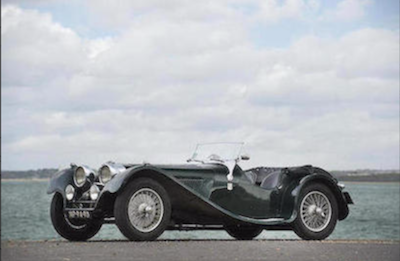
1938 Jaguar Roadster auctions at Goodwood Festival of Speed by Bonham’s
Instead, Bonham’s sold the Jaguar Roadster for more than £337,500, or $445,386.
Looking back at the 2008 financial crisis when the Financial Times Stock Exchange fell 31 percent over the course of the year, the fine art market only declined by 4.5 percent. To Borro’s point, by 2011 the art market had recovered to the record levels of 2007, and grew yearly up until 2015.
Similarly, in the last 35 years, French leather goods brand Hermès’ iconic Birkin handbag has increased in value by more than 500 percent, according to Baghunter.
In the time period evaluated, the S&P 500 has returned an average of 11.66 percent, or 8.65 percent in real returns. But, the S&P 500 averages do not reflect market fluctuations during the 35-year period and assume that investors have neither bought or sold stocks during that time.
Baghunter found that Hermès Birkin handbags have increased in value year over year. The handbag has offered an average annual value increase of 14.2 percent (see story).
“Luxury assets benefit from an international market,” Paul Aitken, CEO/founder of Borro. “Although Brexit may be affecting confidence in the U.K. that doesn’t have a dramatic effect of Patek Philippe sales at Christie’s Hong Kong.

Image from the @Vote_Leave Twitter account
“The global nature of these markets has always been beneficial to us as a company,” he said. “We have always taken into consideration not only local market prices, but international markets which may have higher demand for certain assets.
“Our seven year track record combined with our experienced staff makes me confident that we will be able to continue lending as expected.”
Borro has valued more than 50,000 luxury assets and targets affluent consumers seeking credit at scales not available from traditional lenders. In the Brexit aftermath, Borro has made no changes to its growth forecasts for luxury assets or property lending.
 Suites of the Gods Hotel
Suites of the Gods Hotel – book now
– book now www.bookingsantorini.com #Santorini #santorinihotels #greece #greek #greekislands #suitesofthegods #greekhotels #luxury #hotel #island #travel #travelling #visitgreece #t
www.bookingsantorini.com #Santorini #santorinihotels #greece #greek #greekislands #suitesofthegods #greekhotels #luxury #hotel #island #travel #travelling #visitgreece #tAdvertising in the wrong places can do more harm than good, according to a study by Rogers Insight.
Consumers’ perception of a brand increases if it advertises on a prestigious Web site but falters if the site is not prestigious enough, suggesting that some ad spots may not be worth the money. Understanding how ad vehicles impact consumer sentiment can help a brand recalibrate its marketing mix to maximize return on investment.
“In regards to daily major newspapers in particular, there are a couple of insights that stand out from a demographic point of view,” said Phillip Crawley, CEO/publisher of The Globe and Mail, part of Globe Media Group. “Forty-seven percent of respondents with a household income of more than $100,000, as well as the highest educated segment (university degree/graduate or professional degree), ranked daily newspapers as number one.
“Managers, owners, professionals and entrepreneurs are also as likely as others to rate daily newspapers as prestigious,” he said.
“Context Matters Consumer Study,” conducted in partnership with the Canadian Marketing Association, Marketing magazine and Globe Media Group, asked more than 4,000 consumers about the importance that media outlet’s prestige had on perception of advertisers.
High prestige
The study reveals that 25 percent of consumers would view a brand more positively if they see it advertised on a site they hail as being among the most prestigious, although 5 percent would see the brand less positively.
However, on a site deemed the “least prestigious,” 38 percent would view the brand more negatively and only 6 percent would see it more positively.
Similar numbers occur for non-luxury automotive brands, banks and financial services businesses and airlines. Although the study did not account for other sectors such as fashion, beauty or jewelry, the uniform response across those that were studied suggests the results would be comparable.
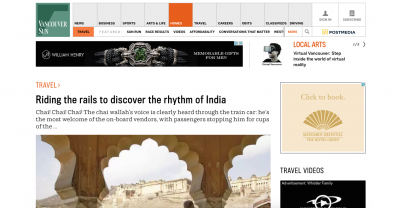
Vancouver Sun with Mandarin Oriental ad
Overall, 63 percent of Canadians said it is “somewhat,” “very” or “extremely” important for brands to advertise on prestigious sites to maintain positive associations.
For a significant plurality of respondents, the sites of major daily newspapers such as the Toronto Globe and Mail or the Vancouver Sun are the most prestigious. Forty-three percent ranked newspapers first, and more than half of those who did not placed the media in the top three.
Major national magazines, such as Macleans, finished a distant second for “most prestigious,” being cited by 11 percent of consumers. Online natives, including Buzzfeed and Huffington Post, placed third at 9 percent, while free dailies and YouTube each garnered 7 percent.
Interestingly, luxury car advertisers stood out in that newspapers were deemed only the second best outlet for advertising. “Sites for business professionals” ranked highest.
Nevertheless, the high placement of newspapers among a vast majority of consumers as both a prestigious and appropriate outlet should make them more attractive to advertisers.
Brands and newspapers alike can feel comfortable with more ads, as only 1 percent said that having a site with fewer ads or an uncluttered look is important.
The biggest determinants of prestige for consumers in the study were that the outlet is a trusted source of unbiased information, is well-designed and produces original content. Being targeted to a specific audience mattered to only 18 percent of respondents; “original content,” the next-lowest ranked characteristic, still mattered to 53 percent.
While the study was exclusive to Canada, the relationship between ad spots in prestigious outlets and consumer sentiment likely extends to other nations. Determinants of prestige are also likely to be comparable abroad.
Effective advertising
While placement is one factor that can predict ad performance, innovations in the ads themselves have also drawn markedly positive consumer response.
For example, Toyota Corp.’s Lexus is among the brands to see significant improvement in responsiveness to mobile advertisements that incorporate TouchSense technology.
Working with advertising and marketing platform Opera Mediaworks and Immersion, the developer of TouchSense technology, Lexus saw sizable increases in click-through rates, completed views, replay rates and ad recall for touch-enabled ads. As mobile use increases and brands fight to engage viewers saturated with advertising, haptic ads offer a way to stand out (see story).
Ineffective advertising can have lingering detrimental effects on a brand.
In a recent Boxever survey, more than half of respondents said they do not want brands to have any personal information, with the number skewing even higher in the travel industry.
Boxever links the overall problem to advertising, noting that half of respondents shop online several times a month. Still, 95 percent see the same ads at least once per week and 75 percent see the same ads between five and 10 times per week (see story).
“Determining the appropriate marketing mix for a brand continues to be complex,” Mr. Crawley said. “It is integral that advertisers have strong resources to refer to when considering the appropriate marketing mix.
“The intent of this study was to understand the effect of context on brands in a digital environment,” he said. “What the Context Matters Consumer Study shows is that context does matter.
“Generally, sites with original content are seen as most prestigious, with Web sites of major daily newspapers topping the list. The negative effect of advertising on a less prestigious site is significantly stronger than the positive impact of a premium site and the impact is even greater for those in the highest income households ($150,000+) and those with the highest levels of education.”